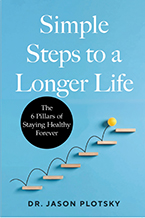May 15, 2025
Simple Steps to a Longer Life:
The 6 Pillars of Staying Healthy Forever
Dr. Jason Plotsky
(2025)
ISBN: 978-1069452801
New Book Offers Valuable Advice for Extending Life by Staying Healthy
 Dr. Jason Plotsky is a man with a mission. After his father, who had never been sick, died of a heart attack at age sixty-two, Plotsky realized appearing healthy and being healthy were not the same thing and that his family history meant he better pay attention to his health. As he states, “A lack of symptoms is not the definition of health; one does not cancel out the other,” and “judging your overall health by how you feel now is a bad plan.” After his father’s death, Plotsky went on to become a doctor, and now, he has compiled a career’s worth of knowledge into his new book Simple Steps to a Longer Life: The 6 Pillars of Staying Healthy Forever.
Dr. Jason Plotsky is a man with a mission. After his father, who had never been sick, died of a heart attack at age sixty-two, Plotsky realized appearing healthy and being healthy were not the same thing and that his family history meant he better pay attention to his health. As he states, “A lack of symptoms is not the definition of health; one does not cancel out the other,” and “judging your overall health by how you feel now is a bad plan.” After his father’s death, Plotsky went on to become a doctor, and now, he has compiled a career’s worth of knowledge into his new book Simple Steps to a Longer Life: The 6 Pillars of Staying Healthy Forever.
Even if you are healthy at this moment, it’s worth paying attention to your health since, as Dr. Plotsky notes, an estimated 70 percent of North Americans will be diagnosed with a chronic disease by age sixty-five. The most common chronic diseases are what he calls “The Big Four”—cancer, diabetes, neurodegenerative diseases/dementia, and cardiovascular disease. However, through taking preventative measures now—simple concrete actions—we can turn that future around for ourselves without having to eat only lettuce the rest of our lives. Dr. Plotsky believes as long as you stick to your health strategy 90 percent of the time, you can stay in peak condition.
Before discussing topics like exercise and nutrition, Dr. Plotsky says it’s important to know our why—why do we want to be healthy? Your why might be your family, because you want to travel, or because you have projects you want to do. Whatever your why is, knowing it will motivate you to implement the good habits he discusses.
Dr. Plotsky also firmly believes that you can heal your body. He cites how 97 percent of your body’s cells replace themselves in one year, so by removing non-healthy food and drink from your diet, you can give your body a chance to recover and basically recreate itself anew. You also need to adopt the mindset that you are a person with healthy habits. He then offers a roadmap for breaking your bad habits, and rather than go cold turkey or focus on eliminating things, he says to focus on adding good things. Walk five minutes; then add a couple of minutes each day. Add five pushups to your morning routine, and then add some more and other forms of exercise. Gradual improvement will lead to phenomenal results over time.
The bulk of Simple Steps to a Longer Life goes into detail about each of the six pillars of good health, which are movement, mobility, sleep, supplementation, food, and stress management. I won’t discuss all of these topics, but one that especially resonated with me was sleep. I don’t always sleep well, and I think that is stress-related, so stress management was also a valuable topic for me. Dr. Plotsky discusses the value of sleep by stating, “When someone tells us they’re struggling to lose weight, we often ask what their nutrition and exercise habits look like. We rarely ask how they’re sleeping.” Without enough sleep, our food cravings increase, and we also have more difficulty breaking down sugar. Sleep is vital to both weight loss and having enough energy to lose weight. Dr. Plotsky explains that when people are sleep-deprived, even for a short time, it affects their insulin responses and how their bodies process food. Their satiety hormones, which tell them when to stop eating, also get messed up.
I never thought about how sleep was connected to weight loss, so it was a revolutionary idea for me. I know I eat more sweets and drink more coffee when I don’t sleep to try to keep my energy up. It’s a vicious cycle, but one I’ll be more aware of going forward. As the book continues, Dr. Plotsky discusses food habits, including how to cut down on and eliminate processed and fat foods and, of course, sugar.
The book’s tips for reducing stress were also helpful. Dr. Plotsky discusses box breathing as a technique for reducing stress, something the Navy SEALs use. I’ve tried it and know it works, not just for stress but anxiety. Now I just have to remember to do it rather than let myself spiral.
Dr. Plotsky also offers a checklist for determining if you are Level One or Level Two in your health. It’s important to remember not everyone starts in the same place when they choose to improve their health. Level Ones probably get no exercise and don’t eat healthy foods. Level Twos get some exercise and eat moderately well. But we can improve in either case. Because Level Threes are extreme athletes, they aren’t discussed in this book. Our goal isn’t to become an athlete, just a healthy person here. Our level will determine what we will and can do. Dr. Plotsky states, “You have to be able to say, ‘Over the next X number of weeks, this is the number-one thing I’m committed to doing,’ and mean it. Write it down. If you’re in Level One, maybe shoot for two or three weeks. If you’re in Level Two, try for thirty days. You want to set these things up as reflexes, where you don’t even have to think about doing them.”
Once you create new and good habits, Dr. Plotsky teaches how to track your habits so you make sure you are following them at least 90 percent of the time, and also, so you don’t have to beat yourself up if you have a piece of cake at a birthday party.
Over time, by applying the advice in this book, you can get excited about being healthy and look for more you can do. As a result, you’ll get a supercharged immune system, prolong your life, and have the energy to do the things you love, plus more time to spend with those who are important to you. I’ve already started to implement some of these techniques and am enjoying better sleep. I wish you similar success in your own health journey.
For more information about Simple Steps to a Longer Life and Dr. Jason Plotsky, visit www.DrJasonPlotsky.com.
— Tyler R. Tichelaar, PhD and award-winning author of The Mysteries of Marquette

